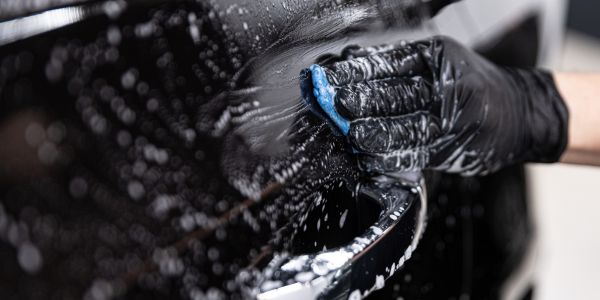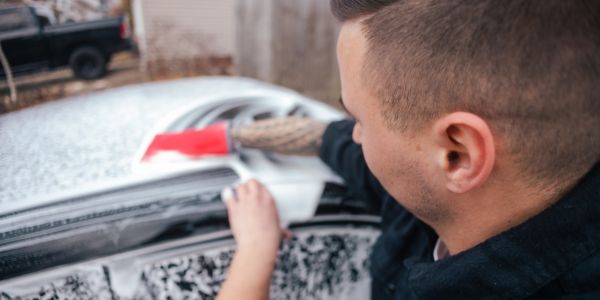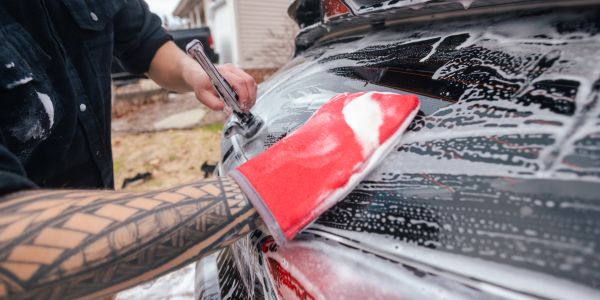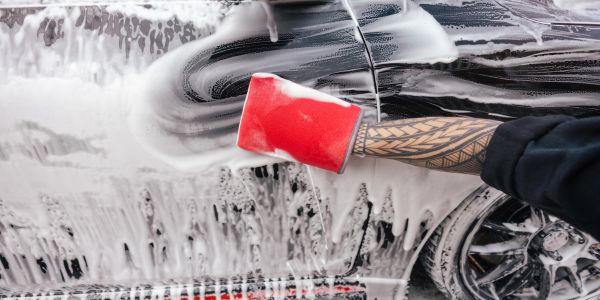This question has been a topic of considerable debate and curiosity among car enthusiasts and detailing aficionados alike. Ceramic coatings have gained immense popularity in recent years for their unparalleled protection and durability, creating a hydrophobic and glossy shield on a vehicle’s surface. Meanwhile, clay bars are a well-established tool in the detailing world, known for their ability to remove contaminants and imperfections from a car’s paintwork.
In this article, we will delve into the intriguing realm of ceramic coatings and clay bars, exploring whether the latter can be used to remove the former. We’ll uncover the nuances of each product, their roles in car care, and the considerations you should keep in mind when deciding whether or not to clay bar a ceramic-coated vehicle. So, if you’ve ever wondered about the compatibility of these two essential detailing tools, read on to unravel the mysteries and myths surrounding the question: “Will Clay Bar Remove Ceramic Coating?”
How is clay bar work?

A clay bar is a detailing tool used to remove contaminants and imperfections from a vehicle’s paint surface, leaving it smooth and free of blemishes. Here’s how it works in about 200 words:
A clay bar is typically a malleable, synthetic resin compound that is formulated to be slightly abrasive. When detailing a car, the first step is to lubricate the surface with a specialized clay lubricant or soapy water. This lubrication is crucial to prevent the clay from scratching the paint.
To use a clay bar, you take a small piece and knead it into a flat, pancake-like shape. Gently glide the clay bar across the lubricated surface. As you do so, the clay bar will pick up contaminants embedded in the paint, such as road grime, industrial fallout, tar, tree sap, and even some types of overspray.
The clay bar works by using its slightly abrasive properties to dislodge these contaminants from the paint surface. It’s essential to maintain proper lubrication to ensure that the clay glides smoothly and doesn’t cause scratches. When you’re done, you’ll notice that the clay bar has changed color and texture, indicating that it has pulled contaminants from the paint.
After claying, your vehicle’s paint will feel noticeably smoother to the touch, and it will be better prepared for subsequent detailing steps like polishing, waxing, or applying ceramic coatings. Regular claying helps maintain a clean and flawless paint finish, enhancing the overall appearance and longevity of your vehicle’s exterior.
Can Clay Bar Remove Ceramic Coating?
Clay bars are not typically designed to remove ceramic coatings from a vehicle’s paint surface. Ceramic coatings are highly durable and chemically resistant, providing long-lasting protection against environmental contaminants. This resilience makes them difficult to remove using traditional detailing methods.
Ceramic coatings form a strong bond with the paint, creating a protective layer that is resistant to most common contaminants like dirt, water spots, and bird droppings. Clay bars, on the other hand, are designed to remove surface contaminants, such as embedded dirt, tar, tree sap, and minor imperfections, but they do not possess the necessary abrasive properties or solvents to break down and remove a ceramic coating.
Attempting to use a clay bar to remove a ceramic coating is unlikely to be effective and may even cause unnecessary friction and potential damage to the coating or the underlying paint. If you wish to remove a ceramic coating, it is recommended to seek professional assistance or use a specialized coating removal product specifically designed for this purpose.
In conclusion, while clay bars are excellent for maintaining and cleaning your vehicle’s paint surface, they are not suitable for removing ceramic coatings, which require different techniques and products for their removal.
Is safe to use clay bar on ceramic coating?
It is generally safe to use a clay bar on a vehicle with a ceramic coating, but caution is essential. Ceramic coatings are highly durable, and a clay bar should not damage the coating itself. However, ensure you use plenty of lubrication, like a clay bar lubricant or soapy water, to minimize friction and the risk of scratching.
Use a gentle touch, and avoid aggressive pressure during the claying process. While clay bars are designed to remove contaminants, they are not intended to remove the ceramic coating. Always follow best practices for detailing to maintain the integrity of both the coating and the paint underneath.
Will clay bar remove ceramic coating?

No, a clay bar will not effectively remove a ceramic coating from your vehicle’s paint surface. Here’s a detailed explanation of why:
Ceramic Coating Durability:
Ceramic coatings are highly durable and chemically resistant. They form a strong, semi-permanent bond with the paint, creating a protective layer that is resistant to environmental contaminants, UV rays, and harsh chemicals. This durability makes ceramic coatings challenging to remove through traditional methods.
Clay Bar Functionality:
Clay bars are designed to remove surface contaminants like dirt, road grime, tar, tree sap, and minor imperfections. They work by using mild abrasion to dislodge these contaminants from the paint’s surface. However, they do not have the necessary abrasive properties or solvents to break down and remove the robust ceramic coating.
Potential for Damage:
Attempting to use a clay bar aggressively on a ceramic-coated surface can lead to unnecessary friction, which may cause micro-marring or scratching. This could compromise the appearance of the ceramic coating and the underlying paint.
Specialized Removal Required:
To remove a ceramic coating properly, you should use specialized coating removal products or seek professional assistance. These products are formulated to break down the coating’s chemical bond without harming the paint underneath.
In summary, while clay bars are excellent for maintaining and cleaning your vehicle’s paint surface, they are not suitable for removing ceramic coatings. Attempting to do so may result in ineffectiveness and potential damage, so it’s advisable to follow the correct procedures for ceramic coating removal when needed.
When should I use clay bar on ceramic coating?

Claying a ceramic-coated vehicle can be a part of regular maintenance to keep the coating and paint looking their best. Here’s when and why you might consider using a clay bar on a ceramic-coated surface:
- Surface Contamination: Even though ceramic coatings are highly protective, they can still accumulate surface contaminants over time. These contaminants can include light dirt, dust, water spots, and airborne pollutants. Using a clay bar can effectively remove such contaminants, ensuring that the ceramic coating’s hydrophobic and glossy properties are fully functional.
- Smoothness: Claying can enhance the smoothness of the ceramic-coated surface. Ceramic coatings already make the paint incredibly smooth, but occasional claying can make it even smoother to the touch, giving your vehicle a slick, polished feel.
- Preparation for Maintenance: If you plan to reapply or refresh the ceramic coating, using a clay bar before doing so can ensure that the surface is entirely clean and free of contaminants. This helps the new coating adhere properly for maximum longevity and performance.
- Visual Enhancement: Claying can help maintain the aesthetic appeal of your vehicle. It can remove minor imperfections and water spots, leaving the paint looking pristine and reflective.
However, when claying a ceramic-coated surface, it’s crucial to follow best practices:
- Use a clay lubricant or soapy water to minimize friction and prevent scratching.
- Apply gentle pressure to the clay bar, and only clay the surface when it’s clean and wet.
- Inspect the clay bar for contamination and knead it to expose a clean surface as needed.
- After claying, consider applying a ceramic coating to refresh or enhance the existing one.
In summary, you can use a clay bar on a ceramic-coated surface as part of regular maintenance to keep the coating looking and performing its best. It can help remove surface contaminants, enhance smoothness, and prepare the surface for reapplication if needed.
Why I choose clay bar to remove ceramic coating?

Choosing to use a clay bar to remove a ceramic coating is not a recommended approach. Ceramic coatings are designed to be durable and long-lasting, making them resistant to most common contaminants and environmental factors. Here are a few reasons why using a clay bar to remove a ceramic coating is not advisable:
- Ineffectiveness: Clay bars are designed to remove surface contaminants like dirt, tar, tree sap, and minor imperfections. They work through mild abrasion and are not equipped to break down the strong chemical bond formed by ceramic coatings. Trying to remove a ceramic coating with a clay bar is likely to be ineffective.
- Risk of Damage: Attempting to use a clay bar aggressively on a ceramic-coated surface can cause unnecessary friction and potentially lead to micro-marring or scratching. This could harm the appearance of the ceramic coating and the underlying paint, resulting in a less-than-desirable finish.
- Specialized Products: To remove a ceramic coating properly, you should use specialized coating removal products that are formulated to break down the coating’s chemical bond without harming the paint. These products are specifically designed for this purpose and are more effective and safer than using a clay bar.
- Professional Assistance: Due to the complexity of removing ceramic coatings, especially if you’re unsure of the coating’s condition or type, it’s often best to seek professional assistance. Professional detailers have the experience and knowledge to safely and effectively remove ceramic coatings without causing damage.
In summary, a clay bar is not the right tool to remove a ceramic coating. Attempting to do so may not achieve the desired results and could lead to damage. Instead, use specialized coating removal products or consult a professional detailer for proper and safe removal when necessary.
When to Consider Clay Bar for Ceramic Coating Removal
Consider using a clay bar for ceramic coating removal only in specific situations where it’s deemed necessary or more appropriate than other methods. Here are some scenarios when you might contemplate using a clay bar:
Partial Coating Removal: If you want to remove the ceramic coating from specific areas or panels of your vehicle while leaving it intact on others, a clay bar can be used to target those areas selectively. This might be the case when you’re looking to correct or refinish certain portions of your vehicle’s paint.
Light Wear and Partial Contamination: If the ceramic coating is relatively new and still in good condition but has minor surface contamination or water spots on specific areas, you can use a clay bar to gently remove these issues without entirely stripping the coating.
Preparation for Recoating: When you’re planning to reapply a ceramic coating, you may use a clay bar to prepare the surface by removing any contaminants or residues from the previous coating. This ensures a clean, bond-ready surface for the new ceramic coating.
Testing and Patch Repair:
If you’re experimenting with different ceramic coatings or detailing products and want to test how a new coating adheres, you might remove a small section of the existing coating using a clay bar. This can also be useful if you need to fix or repair a small section of the coating.
Maintenance and Surface Smoothing: Periodic clay bar treatment on a ceramic-coated vehicle can help maintain the surface’s smoothness by removing surface contaminants, making the coating look its best and preserving its hydrophobic properties.
In these scenarios, it’s essential to exercise caution and use a clay bar with a lubricant to minimize the risk of scratching the underlying paint. If you’re uncertain about the process or concerned about potential damage, it’s advisable to consult a professional detailer with experience in ceramic coating maintenance and removal. For complete ceramic coating removal, especially if it’s aged or extensively contaminated, it’s generally recommended to use specialized coating removal products or seek professional assistance.
How to use clay bar to remove ceramic coating

Removing ceramic coating with a clay bar can be challenging and may not be as effective as using specialized coating removal products or seeking professional assistance. However, if you want to attempt it, here’s a general guideline on how to use a clay bar for ceramic coating removal:
Materials You’ll Need:
- Clay bar designed for automotive use.
- Clay bar lubricant or a mixture of water and car wash soap.
- Microfiber towels.
- Automotive detailing clay mitt or clay bar applicator (optional, for larger areas).
Steps:
Prepare the Vehicle: Ensure your vehicle is clean and free from loose dirt or debris. It’s best to work on a cool, shaded surface to prevent the clay lubricant from drying too quickly.
Divide the Work: If you’re only removing the ceramic coating from specific areas, mark those areas or work panel by panel to maintain control and avoid overuse of the clay.
Lubricate the Surface: Spray the clay lubricant or soapy water generously on the area you’re working on. Lubrication is crucial to prevent friction and scratching during the clay bar process.
Prepare the Clay Bar: Knead the clay bar into a flat, manageable shape. You can also use a clay mitt or applicator for larger areas.
Clay the Surface: Gently glide the clay bar over the lubricated area using minimal pressure. Use straight back-and-forth or side-to-side motions. The clay will grab onto the ceramic coating as you work.
Check the Clay Bar:
Periodically inspect the clay bar’s surface for contamination. If it becomes heavily soiled or has picked up a significant amount of the ceramic coating, knead it to expose a clean surface. You may need to use multiple clay bars depending on the extent of the coating.
Wipe Off Residue: After claying, use a clean, dry microfiber towel to wipe away any residue left on the surface. Inspect the area to ensure that the ceramic coating has been removed to your satisfaction.
Repeat as Needed: Depending on the thickness of the ceramic coating and the effectiveness of the clay bar, you may need to repeat the process multiple times to achieve complete removal.
Finish and Protect: After successfully removing the ceramic coating, you may want to consider reapplying a new coating or applying other protective products like wax or sealant to safeguard your vehicle’s paint.
Remember that using a clay bar for ceramic coating removal is a challenging process, and it’s essential to exercise caution to avoid damaging the underlying paint. If you’re uncertain or uncomfortable with this procedure, consider seeking professional assistance or using specialized coating removal products designed for this purpose.
Maintains after using clay bar on ceramic coating
Maintaining your vehicle’s appearance after using a clay bar on ceramic coating is essential to ensure the longevity and effectiveness of the coating. Here are some steps to follow for proper maintenance:
Inspect the Surface: After claying, carefully inspect the ceramic-coated surface to ensure that all contaminants, residues, and any remnants of the old coating have been removed.
Wash the Vehicle: Give your vehicle a thorough wash to remove any remaining clay lubricant, clay residue, or loose contaminants. Use a high-quality car wash soap and a gentle wash mitt to avoid introducing scratches.
Drying: Use a microfiber drying towel or a leaf blower to dry the vehicle gently. Avoid using harsh materials like old towels or chamois that could scratch the paint.
Surface Enhancement: Consider using a detail spray or a quick detailer to further enhance the shine and slickness of the ceramic-coated surface. These products can help maintain the hydrophobic properties and overall appearance of the coating.
Regular Maintenance:
Continue with regular maintenance practices for your ceramic-coated vehicle, which may include:
Routine washing: Wash your vehicle regularly to remove dirt, dust, and environmental contaminants that can accumulate on the surface.
Use pH-neutral or ceramic-coating-friendly car wash soap to avoid degrading the coating’s performance.
Avoid automated car washes with abrasive brushes, as they can cause micro-scratches and prematurely wear down the coating.
Apply a ceramic coating maintenance product (ceramic spray sealant or booster) as recommended by the coating manufacturer. These products can help rejuvenate and maintain the coating’s effectiveness.
Regularly inspect the coating for any signs of damage or wear. Address any issues promptly to prevent further deterioration.
Protection from the Elements: Whenever possible, park your vehicle in a garage or shaded area to protect it from UV rays, bird droppings, and other environmental contaminants that can compromise the coating.
Avoid Harsh Chemicals: Avoid using strong solvents or aggressive chemicals on the ceramic-coated surface, as they can potentially degrade the coating over time. Stick to gentle, pH-neutral cleaning products.
Professional Maintenance: Consider periodic professional detailing services to assess the condition of your ceramic coating and provide any necessary maintenance or reapplication.
By following these maintenance steps, you can help preserve the appearance and protective qualities of your ceramic coating, ensuring that it continues to provide long-lasting benefits for your vehicle’s paint.
FAQ’s
Certainly! Here are some frequently asked questions (FAQs) related to whether a clay bar can remove ceramic coating:
Can a clay bar completely remove a ceramic coating?
No, a clay bar is not typically effective in completely removing a ceramic coating. Ceramic coatings form strong bonds with the paint, making them resistant to removal with traditional detailing methods.
Is there a specific clay bar for ceramic coating removal?
There isn’t a specific clay bar designed solely for ceramic coating removal. Standard clay bars can be used, but specialized coating removal products are generally more effective and safer for this purpose.
Can a clay bar damage the ceramic coating or paint?
While a clay bar is generally safe for use on ceramic coatings, excessive pressure or lack of lubrication can cause micro-marring or scratching. It’s essential to use proper techniques and lubrication to minimize the risk of damage.
Can I clay a ceramic-coated vehicle for maintenance?
Yes, you can use a clay bar on a ceramic-coated vehicle for maintenance. It helps remove surface contaminants and enhances the smoothness of the coated surface, maintaining its appearance and hydrophobic properties.
When should I consider using a clay bar on a ceramic-coated vehicle?
You might consider using a clay bar on a ceramic-coated vehicle for maintenance or when dealing with specific issues like light contamination, water spots, or to prepare the surface for reapplication or testing a new coating.
Are there any alternatives to a clay bar for ceramic coating removal?
Yes, specialized coating removal products are available for safely and effectively removing ceramic coatings. Professional detailing services can also provide expert assistance in this regard.
Can I reapply ceramic coating after using a clay bar?
Yes, after using a clay bar, you can reapply a ceramic coating to the prepared surface for continued protection and enhanced aesthetics.
What is the best way to maintain a ceramic-coated vehicle after claying?
Regular maintenance includes washing with pH-neutral or ceramic-coating-friendly car wash soap, using ceramic coating maintenance products, and inspecting for signs of damage or wear.
Is it necessary to consult a professional for ceramic coating removal?
If you’re unsure about the process or concerned about potential damage, it’s advisable to consult a professional detailer experienced in ceramic coating maintenance and removal.
Can I use clay bar on other surfaces, like glass or wheels, with ceramic coatings?
Clay bars are primarily designed for paint surfaces. It’s best to use specialized products for other surfaces like glass or wheels, especially if they have ceramic coatings.
Remember that while a clay bar can be useful for certain maintenance tasks on ceramic-coated vehicles, it may not be the best option for removing the coating entirely or addressing extensive issues. Specialized products and professional assistance are often better suited for these purposes.
Conclusion
In conclusion, the question, “Will clay bar remove ceramic coating?” remains a point of clarification in the realm of automotive detailing. The consensus is that while a clay bar can be a valuable tool for maintaining and enhancing the appearance of a ceramic-coated vehicle, it is not intended for the complete removal of a well-applied and fully cured ceramic coating.
Ceramic coatings are celebrated for their remarkable durability and protective qualities, which make them resistant to most common contaminants and environmental factors. Attempting to remove a ceramic coating with a clay bar is often ineffective and may carry the risk of surface damage if not performed with utmost care and expertise.
For the purpose of ceramic coating removal, it is recommended to use specialized coating removal products or seek professional assistance. These products and services are specifically designed to break down the coating’s chemical bond without compromising the integrity of the underlying paint.
In the world of automotive detailing, the careful selection of tools and techniques is paramount. While a clay bar has its place in preserving and enhancing the aesthetics of a ceramic-coated vehicle, the complete removal of a ceramic coating requires a different approach, one that prioritizes the expertise and products designed for this particular task.